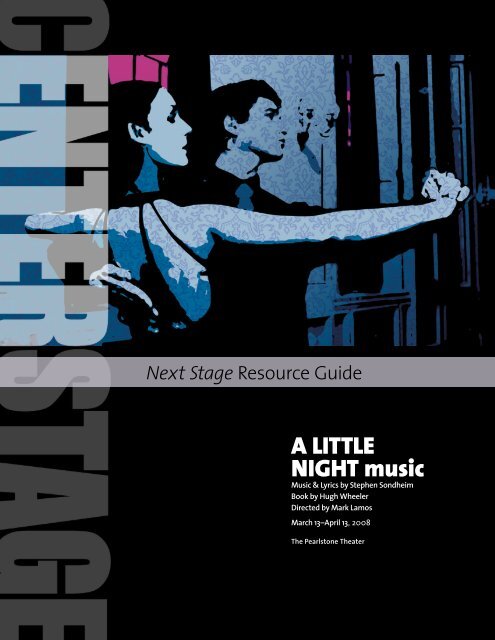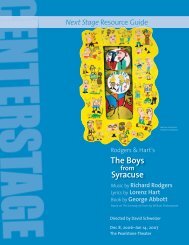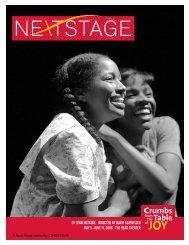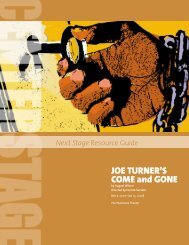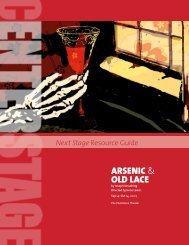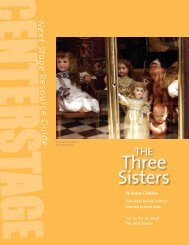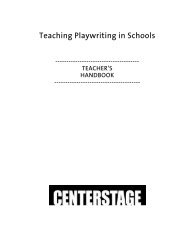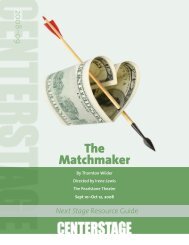Create successful ePaper yourself
Turn your PDF publications into a flip-book with our unique Google optimized e-Paper software.
Next <strong>Stage</strong> Resource Guide<br />
A <strong>LittLe</strong><br />
<strong>Night</strong> <strong>music</strong><br />
Music & Lyrics by Stephen Sondheim<br />
Book by Hugh Wheeler<br />
Directed by Mark Lamos<br />
March 13–April 13, 2008<br />
The Pearlstone Theater
In CASE oF EMERGEnCy<br />
(during performances only) 410.986.4080<br />
Box office Phone 410.332.0033<br />
Box office Fax 410.727.2522<br />
Administration 410.986.4000<br />
www.centerstage.org<br />
info@centerstage.org<br />
The CenTerSTage Program is published by:<br />
CenTerSTage associates<br />
700 north Calvert Street<br />
Baltimore, Maryland 21202<br />
Editor Shannon M. Davis<br />
ContEntS<br />
Setting the <strong>Stage</strong> 3<br />
Cast/Musicians 4<br />
Musical numbers 5<br />
Operetta: a Window into the Past 7<br />
Variations in X Time 8<br />
a Swedish Salon,<br />
or the Stockholm Syndrome 10<br />
Dreams of a Summer night 12<br />
Bibliography 14<br />
the Next <strong>Stage</strong> Resource Guide<br />
is sponsored by<br />
Contributors Shannon M. Davis, Lauren Pierce,<br />
Kathryn Van Winkle, gavin Witt<br />
Art Direction/Design/Illustration Bill geenen<br />
Design Jason gembicki, Brittany Harper<br />
Advertising Sales adrienne gieszl: 410.986.4013<br />
CenTerSTage operates under<br />
an agreement between LOrT<br />
and actors’ equity association,<br />
the union of professional actors<br />
and stage managers in the<br />
United States.<br />
The Director and Choreographer are<br />
members of the Society of <strong>Stage</strong><br />
Directors and Choreographers, Inc.,<br />
an independent national labor union.<br />
The scenic, costume, lighting, and<br />
sound designers in LOrT theaters<br />
are represented by United Scenic<br />
artists, Local USa-829 of the IaTSe.<br />
CenTerSTage is a constituent of Theatre Communications<br />
group (TCg), the national organization for the nonprofit<br />
professional theater, and is a member of the League of<br />
resident Theatres (LOrT), the national collective bargaining<br />
organization of professional regional theaters.<br />
A <strong>LittLe</strong> <strong>Night</strong> <strong>music</strong><br />
Music & Lyrics by Stephen Sondheim<br />
Book by Hugh Wheeler<br />
Mark Lamos Director<br />
Wayne Barker Music Director/Arranger<br />
Chase Brock Choreographer<br />
Riccardo Hernández Scenic Designer<br />
Candice Donnelly Costume Designer<br />
Robert Wierzel Lighting Designer<br />
Scott Stauffer Sound Designer<br />
Gavin Witt Production Dramaturg<br />
Janet Foster Casting Director<br />
Ian Belknap Assistant Director<br />
Ashley Eichbauer Assistant Choreographer<br />
Barbara Irvine Rehearsal Pianist<br />
Robb Hunter Fight Director<br />
PLEASE tuRn oFF oR SILEnCE ALL ELECtRonIC DEvICES.<br />
Sponsored by<br />
A Little <strong>Night</strong> Music is presented through special arrangement<br />
with Musical Theatre International (MTI). All authorized<br />
performance materials are also supplied by MTI.<br />
421 West 54 th Street, New York, NY 10019<br />
Phone: 212.541.4684 Fax: 212.397.4684 www.MTIShows.com<br />
CenTerSTage is funded by<br />
an operating grant from the<br />
Maryland State arts Council,<br />
an agency dedicated to cultivating<br />
a vibrant cultural community where<br />
the arts thrive.<br />
Season Media Sponsor
Set ting the <strong>Stage</strong><br />
A <strong>LittLe</strong> <strong>Night</strong> <strong>music</strong><br />
by Shannon M. Davis, new Media Manager<br />
Characters:<br />
Fredrik Egerman: Dignified, middle-aged lawyer<br />
Anne Egerman: Fredrik’s 18-year-old bride<br />
Henrik Egerman: Fredrik’s 19-year-old son<br />
Petra: Anne’s maid<br />
Désirée Armfeldt: Famous actress; Fredrik’s former mistress;<br />
currently involved with Count Carl-Magnus Malcolm<br />
Madame Armfeldt: Désirée’s mother, at whose country estate the second act takes place<br />
Fredrika Armfeldt: Désirée’s teenage daughter<br />
Frid: Madame Armfeldt’s footman<br />
Count Carl-Magnus Malcolm: Pompous dragoon<br />
Countess Charlotte Malcolm: Carl-Magnus’ wife; Anne’s childhood friend<br />
the Liebeslieder Singers: Chorus<br />
Confusion of the heart. Quotable moments.<br />
Mischievous servants. A contrived weekend in the country.<br />
Sounds like one of Shakespeare’s comedies, doesn’t it? It’s A Midsummer <strong>Night</strong>’s Dream Scandinavian-style:<br />
Stephen Sondheim and Hugh Wheeler’s beloved Tony-winning operetta, A Little <strong>Night</strong> Music. Expectations are<br />
questioned and second chances offered as various couples navigate the tricky choreography of relationships<br />
against the backdrop of turn-of-the-century Sweden. As mismatched lovers finally waltz into their proper<br />
mates’ arms (and beds), Sondheim’s lush score and classic melodies illuminate the stage like the sun that<br />
never quite sets during the magical Nordic summer.<br />
Dignified lawyer Fredrik Egerman has waited eleven long months for his young bride Anne to warm up to<br />
him; is it any wonder that he ends up in the dressing room of his former mistress, actress Désirée Armfeldt?<br />
However, their rendezvous is interrupted by another suitor, Count Carl-Magnus Malcolm—a pompous military<br />
peacock who plans to spend nine hours of his 20-hour leave with Désirée and the following five with his wife,<br />
Charlotte. Charlotte, for her part, has a few tricks of her own. Her husband may be a clumsy philanderer, but<br />
he’s hers, and she vows to get him back.<br />
Paying a surprise visit to her childhood friend, none other than Anne Egerman, Charlotte proposes a plan to<br />
retrieve their spouses from Désirée’s perfumed clutches during a weekend at the latter’s country house. All<br />
the while, Désirée’s aristocratic mother, Madame Armfeldt, dispenses wry romantic advice, as Fredrik’s son<br />
Henrik nurses a desperate crush on his young stepmother and servants Frid and Petra actually get around to<br />
doing what everyone else can’t seem to manage. In true Shakespeare—and Sondheim—style, affairs of the<br />
heart are never simple. ❖<br />
Next <strong>Stage</strong>: A Little <strong>Night</strong> Music |
the CAst<br />
(in order of appearance)<br />
Liebeslieder Quintet<br />
Whit Baldwin* Mr. Lindquist<br />
Jacque Carnahan* Mrs. Anderssen<br />
Amy Justman* Mrs. Nordstrom<br />
Alison Mahoney* Mrs. Segstrom<br />
Joe Paparella* Mr. Erlanson<br />
Polly Bergen* Madame Armfeldt<br />
Mattie Hawkinson* Fredrika Armfeldt<br />
Jonathan C. Kaplan* Frid<br />
Julia osborne* Anne Egerman<br />
Josh young* Henrik Egerman<br />
Stephen Bogardus* Fredrik Egerman<br />
Sarah uriarte Berry* Petra<br />
Barbara Walsh* Désirée Armfeldt<br />
Maxwell Caulfield* Count Carl-Magnus Malcolm<br />
Kate Baldwin* Countess Charlotte Malcolm<br />
Craig A. Horness* <strong>Stage</strong> Manager<br />
Keri Schultz* Assistant <strong>Stage</strong> Manager<br />
*Member of Actors’ Equity Association<br />
the musiCiANs<br />
Wayne Barker Piano/Celeste<br />
Celeste Blasé Violin<br />
Keith Daudelin Woodwind<br />
James Gollmer Horn<br />
Chris Hofer Bass<br />
Lee Lachman Woodwind<br />
Julia Martin Harp<br />
Kirsten Walsh Cello<br />
There will be one 15-minute intermission.<br />
Next <strong>Stage</strong>: A Little <strong>Night</strong> Music |
Musical Numbers<br />
Act one<br />
Overture<br />
Liebeslieders ■<br />
<strong>Night</strong> Waltz<br />
Company ■<br />
Now<br />
Fredrik ■<br />
Later<br />
Henrik ■<br />
Soon<br />
Anne ■<br />
The Glamorous Life<br />
Fredrika, Désirée, Liebeslieders,<br />
Madame Armfeldt ■<br />
Remember<br />
Liebeslieders ■<br />
You Must Meet My Wife<br />
Fredrik, Désirée ■<br />
Liaisons<br />
Madame Armfeldt ■<br />
In Praise of Women<br />
Carl-Magnus ■<br />
Every Day a Little Death<br />
Charlotte, Anne ■<br />
A Weekend in the Country<br />
Petra, Anne, Fredrik, Charlotte,<br />
Carl-Magnus, Liebeslieders ■<br />
Act tWo<br />
Entr’acte<br />
■ Orchestra<br />
<strong>Night</strong> Waltz<br />
■ Liebeslieders<br />
<strong>Night</strong> Waltz II/The Sun Goes Down<br />
■ Liebeslieders<br />
It Would Have Been Wonderful<br />
■ Fredrik, Carl-Magnus<br />
Perpetual Anticipation<br />
■ Mrs. Nordstrom, Mrs. Segstrom,<br />
Mrs. Anderssen<br />
Send in the Clowns<br />
■ Désirée<br />
The Miller’s Son<br />
■ Petra<br />
Reprises<br />
■ Liebeslieders<br />
Reprise: Send in the Clowns<br />
■ Fredrik, Désirée<br />
Last Waltz<br />
■ Company<br />
Next <strong>Stage</strong>: A Little <strong>Night</strong> Music |
Next <strong>Stage</strong>: A Little <strong>Night</strong> Music |
Operetta:<br />
A Window into the Past<br />
by Lauren Pierce, Dramaturgy Apprentice<br />
he year is 1870; the place, Europe—where<br />
opera, once the pinnacle of entertainment and<br />
spectacle, has begun to wane in both popularity<br />
and importance. Perhaps tiring of all the pomp<br />
and tragedy, the rising urban middle classes seem<br />
ready for something new—something to lighten,<br />
brighten, and bring variety to the daily monotony<br />
of the Industrial Revolution. A <strong>music</strong>al counterpart<br />
to the boulevard farces beginning to fill city<br />
theaters. And so, many composers, most famously<br />
Johann Strauss in Vienna and Jacques Offenbach<br />
in Paris, looked to comic operas of old to create a<br />
new form that came to be known as the operetta.<br />
If grand operas were the equivalent of Oscarworthy<br />
epics, operettas were essentially the<br />
half-hour sitcoms of their day. Their storylines<br />
were often frivolous and sentimental, following<br />
predictable patterns with familiar characters, set<br />
to light, pleasant <strong>music</strong> (usually in waltz time).<br />
The typical operetta plot went something like<br />
this: boy meets girl, boy and girl fall in love, boy<br />
and girl are kept apart by some outside force, boy<br />
and girl have a terrible misunderstanding, and<br />
finally boy and girl reconcile and join in marriage.<br />
In some instances, there might be a bittersweet<br />
quality to the final reunion, whereas most<br />
brought their lovers together amidst a large and<br />
joyous celebration. Unlike through-sung operas,<br />
operetta combined scenes of spoken dialogue<br />
with songs closer to the popular parlor songs<br />
of the day than to the arias of grand opera.<br />
In addition to being comic celebrations of the<br />
pleasures and follies of romance, they were<br />
generally shorter and far less spectacular than<br />
operas. They featured smaller orchestras playing<br />
much brighter, happier <strong>music</strong> to match the<br />
romantic subject matter and more-frequent<br />
dance interludes—often waltzes—with little<br />
direct connection to the plot.<br />
By far the most influential and well-known<br />
composer of operetta was the Austrian-born<br />
Johann Strauss, Jr. (1825–1899). His most popular<br />
work was Die Fledermaus, created in 1874, which<br />
became the most-performed operetta in the<br />
world and still remains Strauss’ most popular<br />
stage work. Closely rivaling Fledermaus in<br />
popularity was The Merry Widow, a quintessential<br />
operetta by Austro-Hungarian composer Franz<br />
Lehar. In it, the titular witty, and wealthy, widow<br />
must navigate a plot by her native land—the tiny<br />
principality of Pontevedro—to marry her off to<br />
suave, handsome Count Danilo; while she and the<br />
Count waltz around the issue, they are enmeshed<br />
in secret trysts, glamorous parties, and comic<br />
misunderstandings. The same spirit pervades the<br />
celebrated Savoy operettas of those enduring<br />
godfathers of <strong>music</strong>al comedy, Gilbert and<br />
Sullivan, without whom contemporary <strong>music</strong>al<br />
theater would be very different indeed.<br />
In the early days of Broadway, operettas and<br />
<strong>music</strong>als co-existed side by side, each influencing<br />
the other. Today, operettas tend to be viewed<br />
as rather dated windows into a time gone by;<br />
however, many current composers, from Stephen<br />
Sondheim to Adam Guettel, have taken the<br />
basic form of the operetta and infused it with<br />
contemporary influences in subject, tone, and<br />
<strong>music</strong>. Sondheim in particular has leaned heavily<br />
on the world of operetta in creating some of his<br />
most famous <strong>music</strong>als, such as Sweeney Todd,<br />
Passion, and of course A Little <strong>Night</strong> Music. ❖<br />
Next <strong>Stage</strong>: A Little <strong>Night</strong> Music |
n adapting A Little <strong>Night</strong><br />
Music from Ingmar<br />
Bergman’s 1959 film,<br />
Smiles of a Summer<br />
<strong>Night</strong>, Sondheim fit the<br />
material to the manner:<br />
he retained the virtually<br />
comic operetta setting<br />
and circumstances,<br />
which he translated into<br />
a suitably theatrical form. However, as is typical<br />
of this ever-inventive-and-evolving composer,<br />
Sondheim took the form of his source, opened it<br />
up, altered it, and created something that pays<br />
homage to the old while moving into new domains<br />
structurally, <strong>music</strong>ally, and psychologically.<br />
As in many an operetta, A Little <strong>Night</strong> Music<br />
begins with lovers apart. Here, though, they are<br />
not merely physically separated, but in variously<br />
mismatched relationships that seem destined to<br />
fail. Romantic assignations and intrigue quickly<br />
pervade the atmosphere, but more than adultery<br />
and duels stand in the way of satisfaction. Almost<br />
from the opening notes, we are introduced to<br />
the idea of deep disharmonies among characters<br />
who cannot coexist between “Now,” “Later,” and<br />
“Soon.” Sondheim creates a world off-kilter, not<br />
merely in the typical, lushly romantic sense of<br />
VARiAtions in<br />
3/4 time<br />
by Lauren Pierce,<br />
Dramaturgy apprentice<br />
light opera, but in a more uneasy separation of<br />
characters from reality, their own or others’. Rather<br />
than a <strong>music</strong>al romp to see how many—and<br />
for how long—external obstacles can keep the<br />
lovers apart, Sondheim’s operetta leaves room to<br />
explore loneliness, aging, suicidal self-loathing,<br />
and the disappointments of missed opportunity.<br />
Choices have consequences, and relationships<br />
sting as often as they soothe. In keeping with the<br />
source material in Bergman’s film, the naïveté of<br />
the traditional operetta is gone, and deep inner<br />
tensions pervade the piece both <strong>music</strong>ally and<br />
lyrically.<br />
Some of that <strong>music</strong>al tension comes from the<br />
underlying heartbeat of the score. True to the<br />
world of 19 th -century operetta and its foremost<br />
practitioner, Johann Strauss, Sondheim gives his<br />
entire <strong>music</strong>al a waltz beat. Could anything be<br />
more suffused with sophisticated glamour than<br />
the waltz? Maybe not; but while it evokes the<br />
world of the Belle Époque, the waltz—like Jazz<br />
and Rock since—was once shockingly risqué, so<br />
suggestive that it was considered indecent. With<br />
its initial rise to popularity in the early 19 th Century,<br />
the social and religious leaders of the time actually<br />
regarded the waltz as vulgar and sinful, with its<br />
entwined arms and whirling bodies held close.<br />
Next <strong>Stage</strong>: A Little <strong>Night</strong> Music |
In July of 1816, the waltz was included in a ball given in<br />
London by the Prince Regent; a blistering editorial a few<br />
days later thundered:<br />
We remarked with pain that the indecent foreign dance<br />
called the Waltz was introduced (we believe for the<br />
first time) at the English court on Friday last.... it is<br />
quite sufficient to cast one’s eyes on the voluptuous<br />
intertwining of the limbs and close compressure on<br />
the bodies in their dance, to see that it is indeed far<br />
removed from the modest reserve which has hitherto<br />
been considered distinctive of English females. So long<br />
as this obscene display was confined to prostitutes and<br />
adulteresses, we did not think it deserving of notice; but<br />
now that it is attempted to be forced on the respectable<br />
classes of society by the civil examples of their superiors,<br />
we feel it a duty to warn every parent against exposing<br />
his daughter to so fatal a contagion.<br />
With this backdrop, and a penchant for pushing<br />
boundaries, it is no surprise that Sondheim should<br />
decide to infuse his entire <strong>music</strong>al with a constant<br />
pulse of time. A literal pulse, in that it mimics<br />
the beat of the heart. Whether through actual<br />
waltzes or variations on the theme, a constant<br />
1-2-3 throbs through the entire piece—at<br />
moments quickening, then slowing as the<br />
characters come together and then part ways, in this<br />
slightly fractured ballroom of a <strong>music</strong>al, populated by<br />
fractured people and couples hoping to reassemble.<br />
In style and content both, Sondheim celebrates these<br />
various elements but provides something more than<br />
imitation. He stretches the form even while he honors<br />
the tradition; he evokes the myth of Happily-Ever-After<br />
without giving over to it. As he said of the piece, “I want<br />
the whole show to have a perfumed quality, not just<br />
to bubble like champagne. It is about sex, and I’ll<br />
take care of the bubble, but I want some sense of<br />
musk on the stage at all times.” So, many of his<br />
waltzes are in minor keys, as characters struggle<br />
to connect either with one another or with their<br />
passions. The climactic “eleven o’clock number”<br />
gives us Petra the maid singing of sexual dalliances<br />
amidst a dizzying array of her social betters who can’t<br />
decide what they want. Despite many difficulties, in this<br />
rare instance, it seems that Happily-Ever-After is almost<br />
possible; but there linger notes of discord and a feeling<br />
that, even as these characters waltz off into the night,<br />
a reality lurks that is less than sublime—a hard-won<br />
sense of sweet sadness to balance the smiles. The long<br />
midsummer night will end, the sun will set at last, and<br />
time will march on. ❖<br />
Next <strong>Stage</strong>: A Little <strong>Night</strong> Music |
A Swedish Salon, or the<br />
S t O c k h O l M<br />
S y N d r O M e<br />
hundred years ago: From Stockholm to Rättvik,<br />
Uppsala to Helsingborg, fin-de-siècle Sweden<br />
is transforming rapidly. Industry and education draw<br />
an ever-increasing working class to the cities from the<br />
country; unions and socialist political parties campaign<br />
for workers’ rights and universal male enfranchisement;<br />
outspoken feminist activists fight for independence.<br />
The strict social hierarchy of centuries past continues to<br />
dissolve as the aristocracy surrenders privileges before<br />
egalitarian, progressive advances.<br />
The cultural expression of the time reflects this upheaval:<br />
a cosmopolitan high European culture, influenced by the<br />
fashions of decadent Vienna and glittering Paris, rubs<br />
shoulders with a homegrown nationalist movement<br />
intent on celebrating the values, folk traditions, and<br />
beautiful, brooding landscape of their own Sweden. ❖<br />
1<br />
Talk of the Town<br />
Turn-of-the-century cafés and newspapers are abuzz<br />
with the controversial theories of Freud and Darwin,<br />
the Tibetan travels of Swedish explorer Sven Hedin, the<br />
1896 establishment of the Nobel Prize, the first modern<br />
Olympics, and a bewildering whirlwind of advances<br />
in science and technology. These include everything<br />
from radio telegraphy to radioactivity, automobiles to<br />
airplanes, the discovery of the electron to the spread of<br />
electricity, and the introduction of x-rays, phonographs,<br />
and motion-picture cameras. Meanwhile, in 1905,<br />
Einstein formulates his Special Theory of Relativity,<br />
and Norway votes to split from Sweden.<br />
2<br />
Woman of the World<br />
Désirée Armfeldt, when not appearing in provincial<br />
productions of frivolous, courtly French comedies, stars<br />
in plays by Scandinavia’s leading dramatists—among<br />
them Strindberg’s Miss Julie, and Ibsen’s Hedda Gabler<br />
and A Doll’s House. These innovative plays shock<br />
complacent crowds with their frank, even brutal<br />
examination of the human price exacted by traditional<br />
gender roles, class divides, and moral codes.<br />
by Kathryn Van Winkle,<br />
The Mike and Beth Falcone Dramaturgy Fellow<br />
3<br />
Lutherans and Lust<br />
At seminary, Henrik Egerman trains to<br />
“serve in God’s army” through exacting<br />
study of the works of Martin Luther. His<br />
adolescent gloom, and guilt over his<br />
own body’s impulses, find no relief in<br />
those strict Protestant precepts. If his<br />
reading strays, he might encounter the<br />
polemical anti-Christian philosophy of<br />
Nietzsche or the theology of the Danish<br />
Kierkegaard, who, while criticizing the<br />
established Church, examines doubt as<br />
an element of faith.<br />
4<br />
Portrait of a Period<br />
The successful Fredrik Egermans and<br />
sophisticated Madame Armfeldts<br />
of the day adorn their walls with<br />
the latest conversation pieces, free<br />
to choose among cosmopolitan<br />
Parisian Symbolists, eclectic Viennese<br />
Secessionists, and Swedish painters<br />
who embrace native traditions and<br />
social reform through art.<br />
Pictured: Gustaf Fjaestad’s The Boy<br />
Who Sees with His Heart (1898); Richard<br />
Bergh’s Nordic Summer Evening<br />
(1899–1900); Gustav Klimt’s Medicine<br />
(1900–07).<br />
5<br />
Home and Hearth<br />
Newlywed Anne Egerman may<br />
enjoy flipping through books of Carl<br />
Larsson’s watercolors. The painter has<br />
transformed his favorite models—his<br />
wife Karin and their eight children—<br />
into one of the best-loved families<br />
in Sweden through art depicting the<br />
joys and sorrows of domestic life.<br />
The couple collects folk art, drawing<br />
inspiration from peasant models in<br />
designing their furniture and painting<br />
their home. The watercolors stress<br />
values of simplicity, authenticity, and<br />
heritage, while reflecting Larsson’s<br />
conviction that a pleasant atmosphere<br />
produces happy, healthy people.<br />
Next <strong>Stage</strong>: A Little <strong>Night</strong> Music | 10<br />
1
4<br />
2 3<br />
5<br />
Next <strong>Stage</strong>: A Little <strong>Night</strong> Music | 11
dreams<br />
of a Summer <strong>Night</strong><br />
by gavin Witt, Production Dramaturg<br />
The source that most directly informed A Little <strong>Night</strong> Music (aside from its winkingly Mozartderived<br />
title) was Ingmar Bergman’s uncharacteristically comic film, Smiles of a Summer <strong>Night</strong>.<br />
Bergman’s sprightly comedy of sexual manners itself has a distinguished lineage, inspired not<br />
only by Shakespeare’s A Midsummer <strong>Night</strong>’s Dream, but also by such diverse antecedents as<br />
the operas of Mozart; the mathematical seductions and intrigues in the plays of Marivaux; the<br />
elaborate, sophisticated glamour of films by Ernst Lubitsch and Max Ophüls; and such bittersweet<br />
confections as La Règle du jeu by Jean Renoir and Erotikon by pioneering Swedish director Mauritz<br />
Stiller—a romantic drama whose heroine is married to a Professor, a “shining light in the field of<br />
entomology,” who himself is so preoccupied by his studies of the polygamous nature of beetles<br />
that he’s unaware of what his wife is up to, with a Baron and with a handsome sculptor. These<br />
and a number of other inspirations trace a lineage made up of twin strands, two distinct but<br />
related tropes that appear and reappear throughout plays and films from classical antiquity to<br />
the present.<br />
Next <strong>Stage</strong>: A Little <strong>Night</strong> Music | 12
he first of these is understandably ancient,<br />
and draws its power from the astronomical<br />
landmark of the summer solstice. Bergman<br />
(and Sondheim) set his story during the<br />
Swedish celebrations of Midsummer. The rites<br />
of this festival, celebrating the power and<br />
fertility of the longest day of the year, have<br />
been celebrated since time immemorial. In<br />
Scandinavia, the traditional pagan festivities have long remained<br />
popular (and notoriously raucous), honoring a stretch in which the<br />
sun never actually sets for days at a time. Midsummer’s Eve marks a<br />
pause in the agricultural year and provides an occasion for disguise<br />
and deception, the crossing of social boundaries, and rebellion against<br />
moral stricture, much like Carnival in more southerly climes. What a<br />
ripe and fitting subject for a play.<br />
No wonder, then, that dramatists should be drawn to the subject and<br />
the setting. The backdrop for Strindberg’s classic Miss Julie, for instance,<br />
is a Swedish Midsummer’s Eve, which timing directly informs the lust<br />
and license of its central action. It seems appropriate, even inevitable,<br />
that Midsummer should be the setting for the liaison between the aloof<br />
daughter of a Count and her father’s footman, an erotically charged<br />
encounter that daringly breaches<br />
class boundaries. The transformative,<br />
sensual, and sometimes dangerous<br />
potential of ritual festivities like<br />
Midsummer sometimes spans the<br />
calendar, and often inspires theatrical<br />
mayhem. Similar disorder underlies<br />
Euripides’ The Bacchae, or the witches’<br />
Sabbath of Walpurgisnacht in Goethe’s<br />
Faust. But perhaps the best-known<br />
epitome of this trope is Shakespeare’s<br />
A Midsummer <strong>Night</strong>’s Dream, in which<br />
the lusty madness of a long summer’s<br />
night justly prompts the observation,<br />
“Lord, what fools these mortals be!”<br />
It all must be so beautiful in old Sweden<br />
now—Midsummer time—one almost chokes<br />
up thinking about the long, light nights; the<br />
still, clear bays where birch promontories are<br />
reflected, where cuckoos call and the thrushes<br />
sing wistfully in the woods in the twilight; the<br />
strains of a fiddle and the sounds of dancing in<br />
the distance…rustling in the birches; heart and<br />
eyes and hands full of love; the sun gone, but the<br />
rays remaining, like a gloria around the general<br />
intoxication, in which all the secret longing that<br />
ripened during the long, cold spring releases itself<br />
like a shower of incorporeal flowers that are just<br />
scent, which the soul drinks in….<br />
A second strand that Shakespeare’s<br />
Midsummer also introduces, and which<br />
both Bergman and Sondheim exploit, is<br />
the longstanding tradition of sending<br />
city folk out into the country, the woods, or some other “natural”<br />
setting to let the environment work its magical transformation.<br />
There, amidst trees and brooks and, one imagines, birds and bees<br />
doing what comes naturally, the idea is that civilized folks will do<br />
the same. Sometimes the effects are salutary, as in Midsummer<br />
or As You Like It, with couples going through allegorical purgation<br />
to come out aligned. Sometimes the result is less wholesome, as in<br />
The Bacchae (dismemberment) or King Lear (madness and devastation).<br />
When Sondheim himself revisited the formula in Into the Woods, his<br />
revisionist exploration of fairy tales, he tried both. Perhaps lovers or<br />
pairs of lovers must go through literally purging fire, as in Mozart’s<br />
The Magic Flute; sometimes it is more a class or group finding solace<br />
▼ Richard Bergh, letter from Normandy, 1887<br />
in retreat, as the group of friends does in McNally’s<br />
Love! Valour! Compassion! Other times it is the<br />
gradual perspective and transformation wrought<br />
by isolation and time—as in Chekhov’s Uncle Vanya,<br />
or Turgenev’s A Month in the Country—that realign<br />
priorities or make folly possible. Films frequently<br />
turn the trope into road comedies, like Sturges’<br />
Palm Beach Story or Capra’s It Happened One <strong>Night</strong>,<br />
and use travel as license for love. In the end, though,<br />
whether new couplings ensue or not, what any of<br />
these characters seems to find at the other side of<br />
the festive and pastoral rainbow is themselves. ❖<br />
Next <strong>Stage</strong>: A Little <strong>Night</strong> Music | 1
BiBliogr aphy<br />
Bergman, Ingmar. Images: My Life in Film. Arcade Publishing: New York, 1994.<br />
Bergman, Ingmar. The Magic Lantern: An Autobiography. Viking: New York, 1988.<br />
Brandstätter, Christian, ed. Vienna 1900: Art, Life & Culture. The Vendome Press: New York, 2006.<br />
Gallagher, Fiona. Christie’s Art Nouveau. Watson-Guptill Publications: New York, 2000.<br />
Jay, Mike and Michael Neve, eds. 1900: A Fin-de-siècle Reader. Penguin Books: London, 1999.<br />
Köster, Hans-Curt, ed. The World of Carl Larsson. Allan Lake Rice, trans. Nordic Heritage Service:<br />
London and Green Tiger Press: San Diego, 1998.<br />
Meser, Thomas M. Edvard Munch. Harry N. Abrams, Inc.: New York, 1985.<br />
Nordstrom, Byron J. The History of Sweden. Greenwood Press: Westport, CT, 2002.<br />
Sprague, Martina. Sweden: An Illustrated History. Hippocrene Books, Inc.:New York, 2005.<br />
If you have any trouble using this resource guide—<br />
or for more information on CENTERSTAGE’s education<br />
programs—call us at 410.986.4050. Student group rates<br />
start at just $15. Call Group Sales at 410.986.4008 for more<br />
information, or visit centerstage.org.<br />
Material in our Next <strong>Stage</strong> resource guide is made available free of charge for<br />
legitimate educational and research purposes only. Selective use has been made<br />
of previously published information and images whose inclusion here does<br />
not constitute license for any further re-use of any kind. All other material is<br />
the property of CENTERSTAGE, and no copies or reproductions of this material<br />
should be made for further distribution, other than for educational purposes,<br />
without express permission from the authors and CENTERSTAGE.<br />
Next <strong>Stage</strong>: A Little <strong>Night</strong> Music | 1


